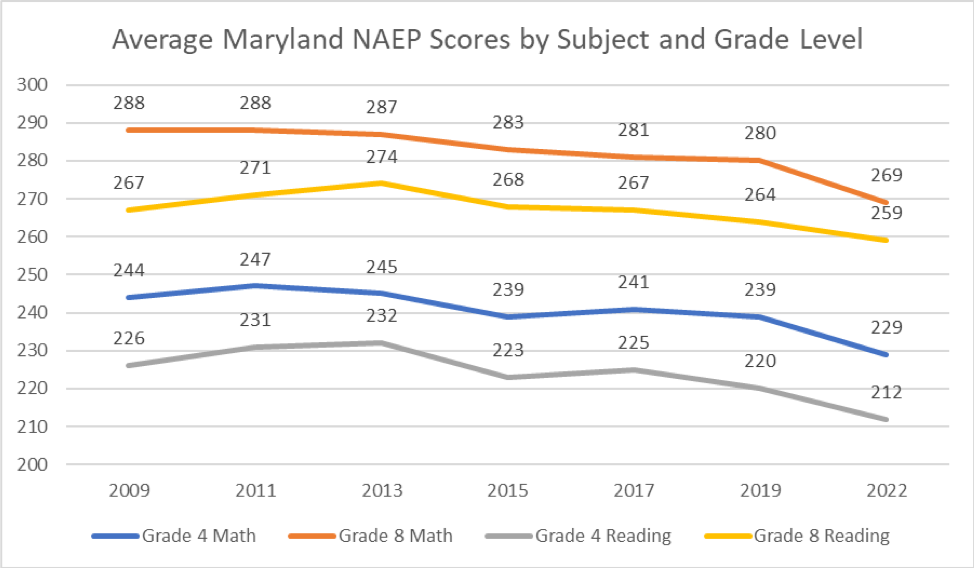Math and reading scores for many students in D.C. area have largely declined, with the region’s most vulnerable students experiencing more significant declines than their peers, according to the latest standardized test data released Monday.
D.C.-area officials released data on Monday from the National Assessment of Educational Progress, often called the Nation’s Report Card, which measures student achievement in math and reading.
Nationally, math and reading scores both declined, though the drops in math were larger than in reading. Students across the country completed the 2022 NAEP test for the first time in three years, and the data paint the latest picture of the impact the pandemic had on student progress.
Students in Virginia, Maryland and D.C. were found to have taken some of the largest declines in achievement in the U.S.
- Test scores show historic COVID setbacks for kids across US
- More Local News
- More DC News
- More Education News
DC
D.C. reported an eight-point decline in fourth grade reading, a 12-point decline in fourth grade math and a 10-point decline in eighth grade math as they were the last time students took the test in 2019. However, this year’s eighth grade reading scores remained the same, which Superintendent Christina Grant attributed to “literacy investments that had been in place and the structure of teaching and learning.”
Results from a different standardized test — the PARCC exam — released last month similarly painted a grim picture of where students stand after months of virtual learning.
“This is sobering data,” said Michelle Walker-Davis, executive director of the DC Public Charter School Board, “and there is an ongoing commitment to see it, understand it, not issue blame against our students, but use that as a call to action to double down on the investments that we’ve taken.”
D.C. reported the largest decline in average score for fourth grade math, and city leaders said during a news briefing that score changes from 2019 to 2022 are largely comparable to other states in the area.
In a statement Monday, the school system cited data from the Trial Urban District Assessment, which uses NAEP. That assessment, it said, demonstrates that “DCPS is maintaining its trajectory as a rapidly improving urban school district, despite the COVID-19 pandemic and a shift to distance learning that spanned two school years.”
“”We know that students need to have their social emotional needs met and they need strong relationships with peers and adults, in order to engage with deep, rigorous academic content,” D.C. Public Schools Chancellor Lewis Ferebee said in that statement.
The District, Grant said, is spending about $1 billion in federal stimulus money to support student growth. Some of that money is being used for high-impact tutoring, which is expected to be offered to more than 8,000 students in the 2022-23 and 2023-24 school years.
Ferebee said the school system has worked with a majority of the students in Wards 7 and 8, “and most of the students who received those services were Black, African American students in the District, which represents some of our challenges that we’ve seen with the opportunity gaps that have expanded during the pandemic.”
Similarly, Ferebee said, the city’s “Latino Hispanic population also experienced significant declines, especially in math. And that’s an area of focus for us to also understand what their needs are.”
The city is also offering schools with subscriptions to Zearn Math, a digital math curriculum and intervention program, and providing literacy training to teachers.
“We cannot have students absent from tutoring; we cannot have students regularly absent from school,” said Paul Kihn, the city’s deputy mayor for education. “And so it’s really, really important that families ensure their young people are in school on time every day.”
Virginia
In Virginia, the previous data comes from 2017. Fourth graders in Virginia saw the largest decline in the nation — with a drop of 13 points, state Superintendent Jillian Barlow said at a news conference Monday morning.
That drop is nearly three times bigger than the national average. Only 32% of Virginia’s fourth graders scored proficient in reading, compared to 43% in 2017.
“Our kids fell nearly three times further than the national average. Our kids’ dreams have not fallen three times further than the national average,” Gov. Glenn Youngkin said at a news conference Monday morning. “We cannot, we must not and we will not sell short our children and their dreams.”
Meanwhile, Virginia fourth grade students tied with Marylanders for the biggest drop in math performance in the nation — 12 points since 2013.
In 2017, half of fourth graders met the standard; five years later, it has dropped to 38% proficiency.
Eighth graders also saw drops in performance — 31% of students were proficient in reading, down from 37% in 2017.
And in math, 31% of eighth graders were proficient, compared to 40% in 2017.
Black and Hispanic students fell behind their peers across grade levels and subjects.
Scores for Virginia’s highest performing students also declined, with fewer students scoring in the advanced category on the test.
Barlow said the pandemic isn’t the only factor — she pointed a finger at lowered standards on tests, among other things.
“For eight years, the previous two administrations systematically lowered standards for schools, lowered expectations for students,” Barlow said. “Lower standards, regardless of how they are marketed, never produce better outcomes for students.”
Using the SOL assessment system — which came to fruition in 1999 — two-thirds of Virginia’s fourth graders are performing well, she said. According to Barlow, Virginia has the lowest reading standard in the nation for fourth grade.
Youngkin has talked about his focus on improving schools and encouraging parental involvement in education since early in his campaign for governor.
“Decisions made over the past years before the pandemic threaten to erase two decades of bipartisan accomplishments in education,” Youngkin said.
Youngkin said he was “doubling down” on his commitment to Virginians and announced plans to get the education system “moving in the right direction.”
Among the plans he laid out include raising testing expectations and partnering with tutoring services Khan Academy and Schoolhouse.world.
The governor called on local school divisions.
“You have nearly $2 billion in remaining federal recovery funds that could be spent on proven learning recovery efforts,” he said.
In a separate statement, Sen. Tim Kaine said many Virginia schools have used federal stimulus funds for things like mental health services.
“I strongly encourage every Virginia school to continue to lean on these resources, and I will keep fighting for additional federal reforms to strengthen our education system like my bipartisan PREP Act to address the teacher and principal shortages that are adding even more strain on our schools,” Kaine said.
Maryland
Maryland’s scores show fourth and eighth graders lagging behind in both math and reading.
“Maryland has been experiencing a downward trend since 2013, and a return to normal is not good enough,” State Superintendent of Schools Mohammed Choudhury said in a news release Monday. “The current struggles of our students cannot be solely attributed to the pandemic.”
The state’s largest learning losses were in math — 75% of eighth grade students and 69% of fourth grade students are at or below basic achievement.
The drop hurt some groups of students more than others. Black students in eighth grade experienced declines in reading and math, as well as in fourth grade math. Hispanic students in fourth grade saw declines in reading and math, and eighth grade math.
“The fourth and eighth grade 2022 NAEP reading and math assessment results confirm that the learning of all students suffered during the pandemic and also underscore the unacceptable opportunity and achievement gaps that continue to persist for Maryland’s Black, Hispanic and economically disadvantaged students,” Choudhury said.
The scores of white students stayed the same in all grades and subjects — except for eighth grade math. The scores of Asian students also held steady.
“As we continue to implement the Blueprint for Maryland’s Future and transform education, we must be innovative, collaborative and bold in our approaches to enhance and accelerate student achievement,” Choudhury continued. “There is no sugar coating these results.”

The average score in fourth grade reading is 212, down from 2020 in 2019. Reading scores went down four-points in that time frame. Just below 70% of students performed at or below the basic level.
Eighth grade reading scores followed with the national average, falling from 264 in 2019 to 259. Eighth grade reading scores showed 32% of students scored at or above proficient, down three percentage points since 2019.
The average math score for fourth graders is 229, down from 239 in 2019. That’s well below the national average of 235.
Eighth grade math scores took a hit as well. The average score is 269, down from 280 in 2019. The national average is 273.
In Maryland, the number of eighth grade students scoring at or above proficient is 25%, a decrease of eight points from 2019.









